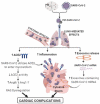Double trouble: combined cardiovascular effects of particulate matter exposure and coronavirus disease 2019
- PMID: 33084879
- PMCID: PMC7665323
- DOI: 10.1093/cvr/cvaa293
Double trouble: combined cardiovascular effects of particulate matter exposure and coronavirus disease 2019
Abstract
The coronavirus disease 2019 (COVID-19) caused by severe acute respiratory syndrome coronavirus 2 (SARS-CoV-2) has rapidly grown into a pandemic. According to initial reports, the lungs were thought to be the primary target, but recent case studies have shown its reach can extend to other organs including the heart and blood vessels. The severity of cardiac complications of COVID-19 depends on multiple underlying factors, with air pollutant exposure being one of them, as reported by several recent studies. Airborne particulate matter (PM) attracts heightened attention due to its implication in various diseases, especially respiratory and cardiovascular diseases. Inhaled PM not only carries microorganisms inside the body but also elicits local and systemic inflammatory responses resulting in altering the host's immunity and increasing susceptibility to infection. Previous and recent studies have documented that PM acts as a 'carrier' for the virus and aids in spreading viral infections. This review presents the mechanisms and effects of viral entry and how pollution can potentially modulate pathophysiological processes in the heart. We aimed to concisely summarize studies examining cardiovascular outcomes in COVID-19 patients and postulate on how PM can influence these outcomes. We have also reviewed evidence on the use of renin-angiotensin system inhibitors, namely angiotensin-converting enzyme inhibitors and angiotensin receptor blockers, in patients with COVID-19. The interplay of pollution and SARS-CoV-2 is essential to understanding the effects of accentuated cardiovascular effects of COVID-19 and deserves in-depth experimental investigations.
Keywords: Cardiovascular diseases; Aerosol; Air pollution; Airborne transmission; COVID-19; Particulate matter; SARS-CoV-2.
Published on behalf of the European Society of Cardiology. All rights reserved. © The Author(s) 2020. For permissions, please email: journals.permissions@oup.com.
Figures



Similar articles
-
COVID-19 and cardiovascular consequences: Is the endothelial dysfunction the hardest challenge?Thromb Res. 2020 Dec;196:143-151. doi: 10.1016/j.thromres.2020.08.039. Epub 2020 Aug 27. Thromb Res. 2020. PMID: 32871306 Free PMC article. Review.
-
Increased complications of COVID-19 in people with cardiovascular disease: Role of the renin-angiotensin-aldosterone system (RAAS) dysregulation.Chem Biol Interact. 2022 Jan 5;351:109738. doi: 10.1016/j.cbi.2021.109738. Epub 2021 Nov 3. Chem Biol Interact. 2022. PMID: 34740598 Free PMC article. Review.
-
Particulate matter and SARS-CoV-2: A possible model of COVID-19 transmission.Sci Total Environ. 2021 Jan 1;750:141532. doi: 10.1016/j.scitotenv.2020.141532. Epub 2020 Aug 5. Sci Total Environ. 2021. PMID: 32858292 Free PMC article.
-
Use of Angiotensin-Converting Enzyme Inhibitors and Angiotensin II Receptor Blockers During the COVID-19 Pandemic: A Modeling Analysis.PLoS Comput Biol. 2020 Oct 8;16(10):e1008235. doi: 10.1371/journal.pcbi.1008235. eCollection 2020 Oct. PLoS Comput Biol. 2020. PMID: 33031368 Free PMC article.
-
The SARS-CoV-2 receptor, ACE-2, is expressed on many different cell types: implications for ACE-inhibitor- and angiotensin II receptor blocker-based cardiovascular therapies.Intern Emerg Med. 2020 Aug;15(5):759-766. doi: 10.1007/s11739-020-02364-6. Epub 2020 May 19. Intern Emerg Med. 2020. PMID: 32430651 Free PMC article.
Cited by
-
Air pollution and cardiovascular disease: Can the Australian bushfires and global COVID-19 pandemic of 2020 convince us to change our ways?Bioessays. 2021 Sep;43(9):e2100046. doi: 10.1002/bies.202100046. Epub 2021 Jun 9. Bioessays. 2021. PMID: 34106476 Free PMC article. Review.
-
Indoor Particle's Pollution in Bucharest, Romania.Toxics. 2022 Dec 5;10(12):757. doi: 10.3390/toxics10120757. Toxics. 2022. PMID: 36548590 Free PMC article.
-
E-cigarettes and arrhythmogenesis: a comprehensive review of pre-clinical studies and their clinical implications.Cardiovasc Res. 2023 Oct 16;119(12):2157-2164. doi: 10.1093/cvr/cvad113. Cardiovasc Res. 2023. PMID: 37517059 Free PMC article. Review.
-
Positive association between outdoor air pollution and the incidence and severity of COVID-19. A review of the recent scientific evidences.Environ Res. 2022 Jan;203:111930. doi: 10.1016/j.envres.2021.111930. Epub 2021 Aug 21. Environ Res. 2022. PMID: 34425111 Free PMC article. Review.
-
Mechanistic Implications of Biomass-Derived Particulate Matter for Immunity and Immune Disorders.Toxics. 2021 Jan 20;9(2):18. doi: 10.3390/toxics9020018. Toxics. 2021. PMID: 33498426 Free PMC article. Review.
References
-
- WHO. Novel Coronavirus—China WHO. World Health Organization. http://www.who.int/csr/don/12-january-2020-novel-coronavirus-china/en/ (24 June 2020, date last accessed).
-
- COVID-19 pandemic. European Centre for Disease Prevention and Control. https://www.ecdc.europa.eu/en/covid-19-pandemic (24 June 2020, date last accessed).
-
- Huang C, Wang Y, Li X, Ren L, Zhao J, Hu Y, Zhang L, Fan G, Xu J, Gu X, Cheng Z, Yu T, Xia J, Wei Y, Wu W, Xie X, Yin W, Li H, Liu M, Xiao Y, Gao H, Guo L, Xie J, Wang G, Jiang R, Gao Z, Jin Q, Wang J, Cao B.. Clinical features of patients infected with 2019 novel coronavirus in Wuhan, China. Lancet 2020;395:497–506. - PMC - PubMed
Publication types
MeSH terms
Substances
Grants and funding
LinkOut - more resources
Full Text Sources
Medical
Miscellaneous

